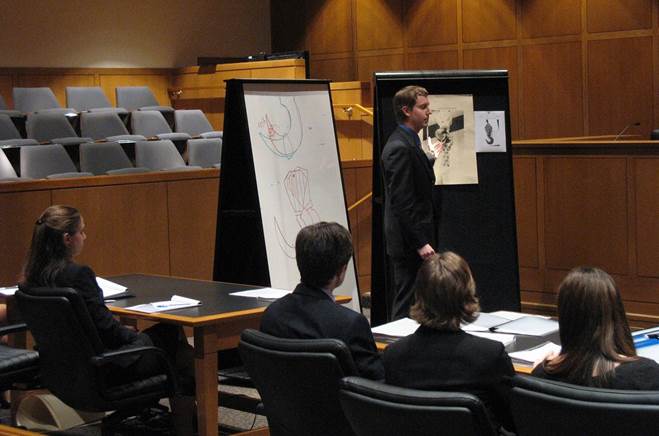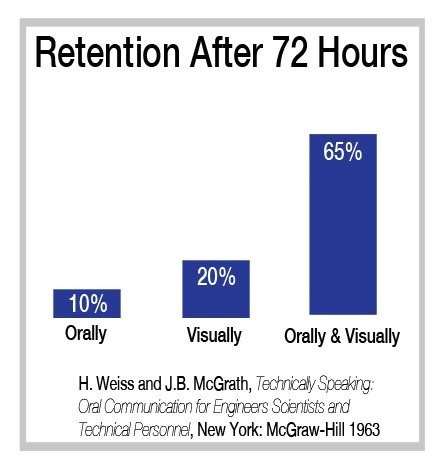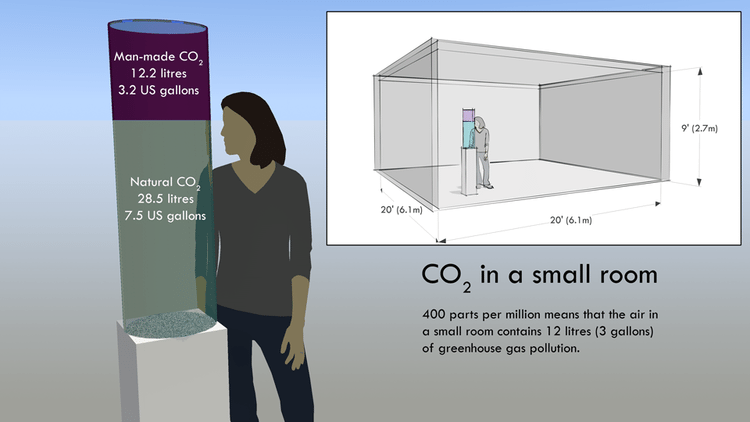
It’s the seventh day of trial, and the novelty has definitely worn off. Your expert is on the stand, methodically slogging through the minutiae of your case, but, frankly, nobody seems particularly excited about it. The testimony has been reduced to a series of spreadsheets, now projected on PowerPoint, but half the jury isn’t even looking at the screen. The case hinges on this testimony, but it’s the middle of the afternoon, and the jury seems confused. Or listless, Or just tuned out. Whatever the case, it isn’t working. And this was wholly avoidable.
Had you spent a little more of your trial prep thinking about your demonstrative exhibits, your expert might be out of his chair, and holding the jury on the edge of their seats. Unlike the substantive exhibits, which you necessarily take as you find them, your demonstrative exhibits can be tailored to clarify or amplify the most interesting aspects of your case. A good demonstrative exhibit can add kinetic energy and color to highlight testimony that would otherwise be static, undifferentiated or unapproachable.
Aside from the basic and obvious evidentiary rules, there really are few limitations on demonstrative exhibit design, aside from your own creativity. It’s really about customizing the exhibit to illustrate the themes and set the tone of your case.
WHY DEMONSTRATIVE EXHIBITS MATTER
From kindergarten, we’re conditioned to sit up and pay attention during show and tell— dutifully passing around and examining the trinkets of childhood. On the evening news, even the most complex stories are presented as 2 minute soundbites with accompanying graphics and a helpful chart or map. On social media, the meme is king—representing or misrepresenting complex issues by using only a line or two of text and a single powerful graphic. The point being that a picture is worth a thousand words. And perhaps as a corollary, a model that your witnesses and the jury can handle is worth at least 1,000 pictures on a PowerPoint screen.
For example, in 1992, McGraw-Hill published the Weiss-McGrath study, designed to examine information retention over time. The study compared information retention across three different modes of presentation: (1) orally only; (2) visually only; and (3) visually and orally together. After the initial presentation, retention was measured at prescribed intervals. After seventy two hours, the group presented only with oral information, retained a mere 10% of the material. The visual cohort retained twice as much, but still topped off at 20% retention. But the third group, which received the information BOTH orally AND visually retained 65% of the material presented, fully three days later. Thus:

To paint the point in starker contrast, ask yourself, which resonated with you more? The preceding paragraph or the visual chart that summarized it?
In any event, Demonstrative Exhibits give you the opportunity to frame and summarize in ways that are bespoke to your themes, in a format that the jury will retain.
BUILDING THE BETTER MOUSETRAP: DESIGNING DEMONSTRATIVES THAT FIT YOUR CASE
But fancier isn’t always better. A good animation can be expensive–$30,000 or quite a bit more, for a flash 3D rendering from CAD drawings. Worse yet, it’s ephemeral. Once the animation is off the screen, it’s gone. And while impressive, it can come across as either polished and professional or inappropriately slick, depending at least in part on how favorably the jury looks upon your client to begin with.
By contrast, a well-designed static exhibit can come across as straightforward and honest. And while it, too, is unlikely to go back with the jury for deliberations, you have a better chance of keeping a static display visible to the jury throughout the trial.
One of the best trial lawyers that I ever worked with preferred to use well-designed static demonstratives, or models, to the exclusion of computer animation. He represented doctors and physician groups in medical malpractice cases. Invariably, the plaintiff’s lawyer would appear in court wearing an expensive suit, driving an expensive car, and brandishing seamless, polished computer animations of whatever medical procedure was at issue. My colleague, by contrast, was slightly rumpled and used clear, but static demonstrative blow-ups, half of which he would knock over, while switching on the easel. The testimony was clear, as were the static illustrations, but it was my colleague who provided the animation. It came across as unvarnished and trustworthy, and jurors always loved him for it. Which is to say that demonstratives need not be sleek to resonate with the fact-finder.
But demonstratives do need to fit with the themes you are trying to develop, and help reduce abstract ideas to concrete presentation. Imagine an environmental case, where relatively small changes in parts per million can be both important and hard to visualize. Consider the below graphic, which is offered not for its substance or climate change commentary, but rather for the way that it quite effectively reduces the abstract idea of 400 parts per million to a more tangible measurement within a juror’s common experience.
By reducing this abstract ratio to the proportional and familiar measurements of a 9×20 foot room, this graphic gives the jurors a hook for understanding the testimony in a specific, approachable way. In fact, if this were my exhibit, I would take it a step further, and scale it to the dimension of the courtroom where the trial will take place. Then, after first showing the fixed graphic on an easel or PowerPoint, I would produce a scale model of the multi-colored cylinder depicted in the image. And balance it on the bar before the jury box (or pass it around if the judge will permit).
For another example of a really effective graphic, consider this image showing the difference between 20 psi and 100 psi:
With a single well-conceived visual, an otherwise abstract differential of three ratios becomes as familiar as a juror’s morning shower. Of course, whatever demonstrative image you choose needs to fit with the themes of your case and the comfort zone of your testifying witnesses.
For another creative use of demonstrative exhibits, consider a trade secrets case, where one of the issues is whether customer lists could be a trade secret. Because at least some aspects of each major customer relationship with this publicly traded company were disclosed in SEC filings, the question for the jury was whether the customer lists as a whole could be proprietary. The answer, at least by analogy, could be found on the back of a can of Coca-Cola®.
There is no mystery what major ingredients go into Coca-Cola®. The ingredients are listed right on the side of the can for review by the public and competitors alike, but that doesn’t change the fact that the actual recipe for Coca-Cola® is one of the most closely-guarded trade secrets in the history of American manufacturing. While a competitor or consumer may realize that Coke® contains carbonated water, sugar, Caramel Color E150d, phosphoric acid and caffeine, that doesn’t mean that the recipe for Coke® isn’t entitled to trade secret protection.
At trial, this point was made in opening statements and repeated by the expert on direct and re-cross. While the expert was on the stand, he walked the jury through this analogy using a blow-up of a Coke® can:

At the same time, an actual can of Coca-Cola®, cold from the courthouse vending machine was passed around the jury box. It was an entirely familiar object, but dutifully passed around to each of the jurors—each of whom took time to inspect the can, feeling its weight, temperature and shape, as well as the writing on the back. It reinforced the themes of the case in a way that every juror could understand. At the end of the case, it was revisited again in closing. But even more, because the court permitted beverages at counsel table, there was always a can of Coke® nearby and in full view from that point forward.
GETTING YOUR DEMONSTRATIVE EVIDENCE ADMITTED
Of course, to do any good, your well-crafted exhibit must first pass judicial scrutiny and get in front of your jury. Generally speaking, evidence comes in two flavors: (1) substantive and (2) demonstrative.
Substantive evidence is the testimonial, documentary and real or tangible evidence admitted in the case. It is governed by Fed. R. Evid. 401 and its state counterparts, and presumes admission where the evidence makes a fact of consequence more or less probable than it otherwise would be. Demonstrative evidence, by contrast, does not make a fact more or less probable, but instead explains or illustrates the substantive evidence previously admitted. Courts have explained demonstrative evidence as “evidence admitted solely to help the witness explain his or her testimony” and caution that such evidence “has no probative force beyond that which is lent to it by the credibility of the witness whose testimony it is used to explain.” Carson v. Polley, 689 F.2d 562, 579 (5th Cir. 1982).
As a practical matter, demonstrative evidence is admissible if three criteria are met: (1) it relates to a piece of admissible substantive evidence or testimony; (2) it fairly and accurately reflects the essence of the substantive evidence; and (3) it aids the trier of fact in understanding or evaluating the substantive evidence. Because demonstrative evidence must be authenticated, it is critically important that your testifying witnesses are involved in each logical stage or component of the exhibit’s creation and can affirm its accuracy.
To use the 400 ppm carbon dioxide example above, it might be helpful to have the witness testify to the dimensions represented on the graphic. Then, when bringing out the scale model of the cylinder, it might be useful for the witness to first affirm that he personally measured the dimensions of the courtroom (perhaps on a break), and then produce a tape measure for the witness to measure the demonstrative model in real time in front of the jury, and affirm its accuracy. This obviously takes work and advance preparation, but can be very effective—and much more visually interesting and memorable than a dry recitation of abstract numbers and ratios from the stand.
WHEN TO USE YOUR DEMONSTRATIVE EVIDENCE
Finally, if considering creative uses of demonstrative evidence, there is no good reason to limit oneself solely to the time of trial itself. To begin with, certainly, demonstrative exhibits should be used with each important witness during the trial, preferably in a combination of charts, pictures, on-screen graphics, and tangible models. Where permitted, they should be used in a way that allows the testifying witnesses to get out of the jury box and interact with their jurors as a teacher, directly and up-close. Those same demonstratives can be used again in summation, as a way of reinforcing the themes of the case. But if that’s all you do, opportunities have likely slipped by you.
For example, any video deposition that may be used at trial is an opportunity to present both the demonstrative on the video screen with the witness at the deposition, and again in the courtroom itself. This works especially well with static displays and models. Thus, while the video is running, and the witness on video is interacting with the display on screen, the same blow-up or model can be live in front of the jury box. Thus making the absent witness seem more present and live in the testimony as it unfolds in the courtroom.
Equally, there are times when the best use of a compelling demonstrative is during the pretrial phase to either argue the substantive motions in limine, or to make an impact in mediation to resolve the suit prior to trial. As to the former, judges are persuaded by the same logic and accessibility of well-crafted demonstrative exhibits that moves jurors, and for the same reasons. Provided the evidence is admissible, and the initial gatekeeping function of the demonstrative is satisfied, the final pretrial is an opportunity to test the force and effect of demonstrative exhibits while addressing other issues before the Court—such as admissibility of the substantive evidence, or the instructions appropriate for the jury charge.
Finally, inasmuch as most civil cases resolve prior to verdict, it is often true that the maximal advantage from your well-crafted demonstrative exhibits stem from their use during settlement talks. To the extent that the demonstrative exhibit could be persuasive to a juror or judge, it may hold equal weight with a neutral mediator. Or give the opposing party something new to worry about in their risk assessment. The well-timed reveal of a demonstrative exhibit can force opposing counsel to come to grips with the weaknesses in their case, especially when reinforced as viable and persuasive by the mediator.
CONCLUSION
A well-crafted demonstrative exhibit can breathe life into dull testimony. It can add clarity to the opaque. It can transform your witness from a distant talking head, sequestered on the stand, into the more familiar and trusted role of an animated and vibrant teacher, explaining difficult concepts in comfortable approachable ways.
But to have maximal impact, these exhibits need to be carefully thought out and planned even as discovery is at its earliest points, and as the initial case themes are being developed and tested. Because, by the seventh day of trial, as your expert marches through the testimony methodically from the distant stand, before a listless jury, it is simply too late.







0 Comments